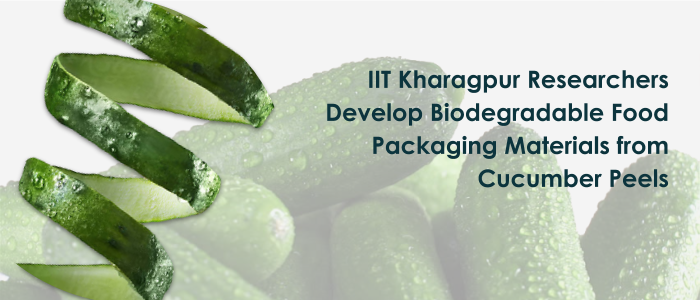
Are you throwing away the cucumber peels after preparing your salad? You may soon have them back in your kitchen as the eco-friendly packaging material for food items.
IIT Kharagpur researchers have developed cellulose nanocrystals from cucumber peels with high cellulose content, compared to other peel wastes, which can be used to create food packaging materials.
While single-use plastic is consciously being avoided by consumers, they still remain largely in circulation as food packaging items. Natural biopolymers are unable to make way in this industry as they lack strength, elongation, barrier property, optical property, and in some cases even biological safety. The cellulose nanomaterial developed by researchers, Prof. Jayeeta Mitra and N. Sai Prasanna at IIT Kharagpur’s Dept. of Agricultural and Food Engineering from raw cucumber waste, has addressed this challenge.
What are cellulose nanocrystals?
Food packaging materials require nano-filler reinforced bio-composites which can be derived from the cellulose widely available from the outer skin of fruits and vegetables. These cellulose fibres can be used to produce cellulose nanocrystals (CNCs), bio-based nanomaterials with defined nano-scale structural dimensions. They are produced through controlled acid hydrolysis which removes amorphous regions, and produces more crystalline regions.

Cucumber-based CNCs Developed by IIT Kharagpur Researchers
In India, cucumber finds wide use in salads, pickles, cooked vegetables or consumed raw and also in the beverage industry leading to a large volume of peel biowaste which is rich in cellulose content.
“Cucumbers generate about 12% residual wastes obtained after processing either the peels or whole slices as waste. We have used the celluloses, hemicellulose, pectin extracted from this processed material for deriving new bio-materials which are useful as nano-fillers in bio-composites,” said Dr. Jayeeta Mitra, Assistant Professor at the Dept. of Agricultural and Food Engineering.
Talking about the findings, she further added, “Our study shows that cellulose nanocrystals derived from cucumber peels possess modifiable properties due to the presence of abundant hydroxyl groups, which resulted in better biodegradability and biocompatibility. These nanocellulose materials emerged as strong, renewable and economic material of the near future, due to unique properties like a high surface area to volume ratio, light in weight, and excellent mechanical properties. Thereby, such nanocrystals, when reinforced as nano-fillers in bio-composites films, can produce effective food packaging materials with low oxygen permeabilities.”

The present study revealed that cucumber peels possessed greater cellulose content (18.22%) than other peel waste. It also provided better insights into their crystalline, thermal and colloidal properties of cucumber cellulose.
Research scholar N. Sai Prasanna said, “The crystallinity percentage as high as 74.1 % along with thermal stability of more than 200 °C negative zeta potential values (< -30 mV), and acid hydrolysis yield of 65.55%, make the material a strong nano-filler reinforcement as bio-nano composite. This offers the much needed mechanical, barrier, optical, rheological properties, nontoxicity, etc. required for food packaging materials which has the strong market potential to replace plastic.”
Market Potential – Application of CNCs and Environmental Sustainability
This non-toxic, biodegradable and biocompatible product has no adverse effects on health and the environment hence could have a huge market potential by rendering management of organic waste with high cellulose content profitable.
“Apart from the food packaging and beverage industries the researchers are optimistic about its scope in various fields like thermo-reversible and tenable hydrogels making, paper making, coating additives, food packaging materials, bio-composites, optically transparent films, as stabilizers in oil-water emulsion. Also, CNCs find good potential applications in biopharmaceutical applications such as drug delivery and fabricating temporary implants like sutures, stents etc.,” added Sai Prasanna.
The researchers further made a note for packaging industry players in our country for substantial investments to improve packaging material properties for better sustainability, disposal and decomposition issues. All these demands for biodegradable packaging will propel the nanocellulose market in the coming timeframe contributing towards a sustainable and plastic-free world, opined Prof. Mitra.
“The incremental usage of petroleum-based plastics in food packaging, spanning a few decades, has raised many challenges as these plastics are the indomitable sources of environmental pollution since nearly 60% of it is converted to landfill, and rest is recycled only once. More research and product development focused on various biopolymers from either macromolecules or from the microbial polymers would be able to make the sector acceptable to packing material producers with wider awareness, alternative products at economic prices,” she remarked.
Cite this paper: Prasanna, N. S., & Mitra, J. (2020). Isolation and characterization of cellulose nanocrystals from Cucumis sativus peels. Carbohydrate Polymers, 247, 116706. https://doi.org/10.1016/j.carbpol.2020.116706
Contacts:
| For Research:
Dr. Jayeeta Mitra, Assistant Professor Agricultural & Food Engineering Department |
For Media: Shreyoshi Ghosh, EO (M&C) Office of Director, IIT Kharagpur |
Media Coverage
About Dept. of Agricultural and Food Engineering
IIT Kharagpur has the sole distinction of having a department in the area of Agricultural & Food Engineering, which comprises six disciplines such as Farm Machinery and Power, Land and Water Resources Engineering, Agricultural Biotechnology, Food Process Engineering, Agricultural Systems Management and Aquacultural Engineering, respectively. The major domain of research and development includes Precision agriculture, biofuel and bioenergy, modern food processing, plasticulture and micro-irrigation, Climate Change, hydrological modeling, groundwater management, water management, agricultural biotechnology, pollution abatement, extrusion technology, intelligent and high-pressure packaging, soil mapping and image analysis for plant phenotyping. Sponsored research projects and development activities deal with Integrated Rainwater Management, Soil Tillage, Utilisation of Fly ash, Ergonomic Database for Agricultural Equipment, Integrating Remote Sensing Data with Distributed Hydrological Models, Model Pilot Plant and koji room facilities for the production of industrial enzymes etc. More info . . .



